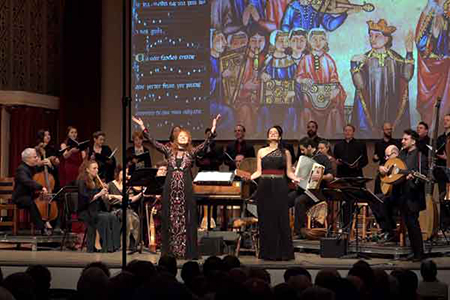by Timothy Robson

“O Jerusalem” was a sensory feast, with its varied music, instruments, and vocal styles, as well as beautiful images projected on a screen above the performers. Sorrell recruited an international cast, including Israeli-born Daphna Mor (vocals and winds — including recorders and the ney, an ancient Middle Eastern flute); Zafer Tawil, a Palestinian musician based in Jerusalem and a virtuoso on the oud (a Middle Eastern version of the lute) and qanun (a Middle Eastern plucked zither); and guest tenors Sorab Wadia and Jacob Perry. Apollo’s Fire regulars soprano Amanda Powell and baritone Jeffrey Strauss also played important roles.
The program was divided into an introductory prologue, followed by “movements” focusing on the Jewish, Christian, and Armenian Quarters; the interrelationship between mosque, synagogue, and cathedral music; and the Muslim Quarter. The finale was a neighborhood “fiesta” using music of the Sephardic Jews.
Some anachronisms (Italian Baroque instrumental dances and excerpts from Monteverdi’s Vespers of 1610) were more imaginative than musicologically accurate, but they served to illustrate the pervasive influence of Middle Eastern music far abroad. The sections of the program flowed seamlessly, and Sorrell and soloists contributed spoken commentary and recitations of poetry and other writings along the way. The instruments, especially the lute, theorbo, harp, oud, and qanun, filled in around the sung works with atmospheric, improvised interludes.
There was perhaps an over-emphasis on music of the Sephardic Jews, those who emigrated to Spain. This is undoubtedly due to Powell’s scholarship and expertise in the Sephardic language and music.
After a somber procession by the choir and instrumentalists to a Sephardic song about the desire to go to Jerusalem, another brighter Sephardic song, Bani Adam (“Children of Adam”), livened things up. Sorrell beautifully recited a poem by 13th-century Persian poet Sa’adi about all people being part of the same body of Adam.
The Jewish Quarter was represented by several Sephardic songs performed by Powell and Mor, and a traditional Hebrew song that would have been sung after the Shabbat meal.
Cellist René Schiffer arranged and performed with the ensemble an Armenian chant, Havun-Havun. Julie Andrijeski, violin, and Mor, recorder, were the soloists in two Baroque dances by Andrea Falconieri and Salamone Rossi. The first act closed with an excerpt from the 13th-century Cantigas de Santa Maria Codex, realized by Sorrell.
At the end of the intermission, the audience was called to take their seats with the Muslim Call to Prayer declaimed by Rex Benincasa and Zafer Tawil, echoing and overlapping each other, and giving a sense of space to their cantillation.
The sacred music of Christianity was represented by the medieval plainchant Sancta Maria succor miseris, followed by a very fine performance of Nigra sum sed formosa by Perry from the Monteverdi Vespers. Hearing the juxtaposition with the Muslim Call to Prayer, one was struck by the possible influence of Muslim chant on Monteverdi’s Christian masterpiece, with its florid, vocal setting of Jewish biblical texts.
Strauss and Wadia superbly sang a Medieval Hebrew prayer, again similar in style to the Muslim chant, followed by a Sephardic liturgical chant. These two works were highlights of the program, such was the intensity of Strauss’s performance. This portion of the program closed with the “Gloria Patri” and the psalm “Lauda Jerusalem” from Monteverdi’s Vespers.
Zafer Tawil improvised dramatically on his oud to open the section of the program dedicated to the Muslim Quarter. He spoke about current day discrimination against Palestinians in Jerusalem, then joined Powell in a traditional Arab/Andalusian song, followed by two lively instrumental Arabic dances.
The concert closed with a neighborhood party with all of the melting pot influences of Jerusalem taking part. La Komida la Manyana (“The Morning Meal”), a traditional Sephardic/Ladino song, was arranged by Schiffer, with all of the soloists and choir eventually joining in. It was a joyous celebration ending a well-conceived and well-executed program.
Published on ClevelandClassical.com March 17, 2020.
Click here for a printable copy of this article



